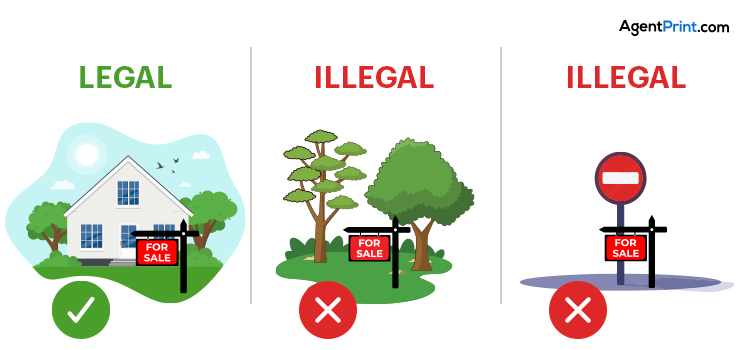Real estate signs are an essential part of property promotion in Canada. By providing a visual representation of the introduction and showcasing process, these signs assist new listings in reaching potential buyers. Those using real estate signs need to follow specific rules about their placement and content. However, they should consider that these standards differ between all areas of Canada. Our guide features the latest 2025 real estate sign rules and guidelines for Canada to help you maintain regulations while reaching more buyers.
Why Understanding Real Estate Sign Rules Matters in Canada
Breaking real estate sign rules creates problems beyond just a bad display. Canada enforces fines and removes signs for agents who disobey sign laws. Reading and following these rules helps real estate professionals avoid any related issues. Pay attention to the open house sign rules and “for sale” house rules to:
- Avoid Penalties: Every Canadian city enforces signage rules through local regulations that include financial penalties. For example, the Alberta Real Estate Association regulation has some specifications in this regard, which are different from Ontario’s.
- Maintain Professionalism: Signs that meet all the regulations help your audience see you as a professional and honest expert.
- Ensure Effective Marketing: Knowing sign placement rules lets you get the best visibility outcomes under approved legislation.
- Protect Client Interests: Adhering to all local signage regulations based on all signage laws in your area is part of your responsibility toward clients.
- Contribute to Community Aesthetics: By following these rules, you protect your neighbourhood’s aesthetic quality.
Who Can Legally Place Real Estate Signs in Canada
Under Canadian law, a real estate professional or property owner has the right to install signs depending on specific guidelines. However, they are obligated to follow the state rules and regulations. Here, we answered a few related questions that we normally hear from homeowners:
Can realtors put signs in my yard?
Real estate agents can put up “for sale” signs or open house signs on a homeowner’s private land with their written permission. The property owner needs to approve the listing agreement before any realtor can place signs on-site. According to both the law and professional standards, a sign cannot be placed unless someone grants permission.
Can estate agents put signs anywhere?

No, it is not a realtor’s choice to place signs anywhere they like. Real estate agents must obey property ownership rules and local rules for putting up signs. State laws stop unauthorized sign placement in public areas, including parks and spaces around traffic signs.
Can I put yard signs anywhere?
The law does not permit you to set up signs at any location. Both homeowners and realtors require legal permission to set up signs. Official bylaws typically forbid certain land placements for signs. The proper dimensions and placement of the signs far from intersections are all under their control. You cannot put unlimited signs on even your private land when rules exist.
General Real Estate Sign Requirements (Size, Placement, and Duration)
All Canadian local governments have their own sign regulations, yet the following basic conditions must be met:
- Size Restrictions: Municipalities control the dimensions of real estate signs because they help keep neighbourhoods attractive and free of visual chaos. These limits are different for “For Sale” signs and “Open House” directional signs.
- Placement Guidelines:
- Listed properties usually allow signs on their private property when the owner gives permission.
- Official permits and police standards sometimes block signs from streets while dictating safe spaces between roadways, sidewalks, and utility boxes.
- Rules limit sign installation around intersections because they could block drivers’ view of oncoming traffic.
- Duration Limits: Property bylaws outline the number of days owners must remove “For Sale” signs once they sell their property. The sign must come down within the first few calendar days after the sale is complete.
For Sale Sign Rules Across Canadian Cities
The regulations about “For Sale” signs differ between provinces in Canada’s real estate industry. Some of them are common, while there are some special tips related to each city that make a difference. As you can see in this file, the City of Vancouver has a distinct document for “real estate signage rules.” The following table compares sign regulations in cities across Canada, but check your local bylaws for official updates:
| City | Typical “For Sale” Sign Size Limit | Placement Restrictions | Removal Timeline After Sale | Potential Fines for Violation |
| Toronto, ON | Varies by zoning, often around 6 sq ft | Setbacks from sidewalks; no placement on public property without permits. | Within 7 days | Varies by infraction |
| Montreal, QC | Specific dimensions based on type (residential or commercial) | Cannot obstruct public pathways; specific distance from street corners. | Prompt removal | Varies by infraction |
| Calgary, AB | Maximum area specified in the bylaws | No placement on public land; it must be within property boundaries. | Within a reasonable time | Specified in the bylaws |
| Vancouver, BC | Limits based on zoning district | Restrictions on boulevard placement must not obstruct pedestrian or vehicle traffic. | Prompt removal | Specified in the bylaws |
Note: Real estate agents must review local municipal rules to follow their specific real estate signage rules when working with properties in that district.
Open House Sign Rules and Limitations
Open house signs serve vital navigation purposes but need strict controls due to their temporary duration and risk of property disruption.
Placement rules for Open House signs
- Private Property: Real estate agents should receive permission from owners to install their signs for open houses.
- Public Property: Open house directional signs placed on public properties are prohibited by various municipalities. The main reason is for the safety and aesthetics of the city, but some allow temporary placement through specified permits.
- Distance from Intersections: The placement of signs near intersections requires strict restrictions. It is because they must not interfere with drivers and pedestrians’ sightlines.
Allowed hours and removal timelines
The authorized time limits for open house sign placement are clearly defined by local regulations. Here are some general tips:
- Allowed Hours: Open house signs should be displayed during the event time frame, but installation and removal must adhere to specific temporal restrictions.
- Removal Timelines: Most jurisdictions require open house signs to come down right after the designated time frame ends. Leaving your signs out in public after selling the house or for prolonged periods will result in financial penalties.
Differences between municipalities
Different cities establish their own distinct guidelines regarding the regulations surrounding open house signs. The rules for directional signs on public boulevards differ between municipalities. Some allow specific permitted signage, yet others maintain total restriction.
Real Estate Signs on Private vs Public Property
The placement of signs depends on determining which properties belong to private ownership and which ones are public.

When is permission required?
- Private Property: All real estate signs need explicit consent from property owners, typically through sellers, before installation can proceed. A written authorization regarding listing agreements should document this permission.
- Public Property: Placement of signs on public land requires both municipal permits and authorization. Real estate signs face restrictions on public properties, requiring special permits during open house events with strict limitations.
Where not to place signs legally
Several cities limit the placement of real estate signage because they are considered off-limits for this purpose, including:
- Public Parks and Green Spaces: To maintain public amenities together with aesthetic value.
- Roadways and Median Areas: Traffic safety regulations prohibit real estate signs from appearing on roadways and medians.
- Attached to Traffic Signs, Utility Poles, or Streetlights: Signs should not be placed on or near traffic signs, utility poles, or streetlights. Because they can create safety hazards and disrupt public infrastructure.
- On Neighbouring Private Property Without Explicit Permission: Maintaining a proper distance from other people’s private property is a basic requirement.
- Any Location That Obstructs Pedestrian or Vehicle Traffic: The signs should not disrupt public safety and accessibility.
Penalties for Non-Compliance With Signage Laws
If you do not follow real estate sign bylaws in Canada, you may face several punishments, including:
- Fines: Municipalities will charge defined fines for each sign violation that start at $10 and reach up to $100 per offence. Multiple violations can create more severe fines.
- Sign Removal: The bylaw enforcement officers can take down illegal signs on the spot and charge the realtor or brokerage for retrieving them.
- Legal Action: Law enforcement has the right to take legal measures against serious or ongoing unauthorized sign actions.
- Damage to Reputation: Frequent sign law violations cause both realtors and their brokerages to lose trust from clients and potential new clients.
Brokerage Responsibilities in Sign Management
Real estate brokerages in Canada need to control their agents’ sign activities according to Canada-wide standards.
Ensuring compliance for all agents
Brokerages should create requirements and offer educational materials for their real estate agents about regional sign rules. This includes:
- Providing agents with training on municipal bylaws.
- Teaching their agents about how to get official approvals.
- Managing sign placement by watching and making sure agents take down signs fast enough.
- Featuring one main system to handle and deal with signs through the team.
Branding and legal display elements
The brokerage requires its agents to use branded signs, which must show both their logo and these mandatory details:
- Brokerage Name and Logo: To ensure easy recognition.
- Legally Required Disclosures: Making sure that all relevant legal text is present and of the right size.
Design and Content Guidelines for Real Estate Signs
Your sign needs good design and information to capture viewers’ attention and tell them what you want them to know.

What must be included: name, contact, brokerage
Real estate signs throughout most Canadian areas need to display relevant information prominently. The most important ones include:
- Licensed Agent Name: Having a licensed agent’s name ensures that someone takes responsibility.
- Agent’s Contact Information (Phone Number and/or Website): Making it easy for people who want to reach out later.
- Brokerage Name and/or Logo: Showing the company or brokerage behind the listing.
Font size, material, colour, and visibility rules
Public safety and visibility guidelines include signage dimensions, permitted materials, and colours.
- Minimum Font Sizes: To guarantee readability from a distance.
- Allowed Materials: Property signs should use durable materials that stand up to weather conditions.
- Colour Restrictions: Certain areas enforce colour restrictions for community design and public sight safety.
- Height and Setback Requirements: It is necessary for general safety and visibility.
FAQ—Common Real Estate Signage Questions in Canada
Do I need to take down my sign once the property sells?Definitely. All municipalities enforce quick removal rules for “For Sale” signs within 48-72 hours after selling the property. Keeping signs active may lead to penalty payments.
How many signs can an agent put up during their open house event?
Every Canadian municipality sets its own rules about how many open house signs realtors can set up. They may either limit one property sign while permitting numbered directional signs, or they strictly prohibit all public signage.
Are A-frame real estate signs permitted?
The rules for using A-frames during open houses depend exclusively on the community laws. Local requirements determine if and how agents can use A-frames. Some cities permit them as long as you follow placement rules, but other cities ban them to prevent sidewalk blockages.
Final Words
Real estate companies across Canada continue using printed signs for advertising purposes. Following local rules ensures your real estate signs work well enough to get attention while remaining legal. By staying updated on 2025 regulations and checking local bylaws, you can build a professional reputation while preventing fines. This will boost your ability to serve real estate clients in Canada.
After reviewing your regional regulations for the real estate signs, AgentPrint.com will help you print the signage in any required size and form. You can rely on our printing materials and quality to receive the best reaction and attract more customers. AgentPrint takes care of printing; you take care of your real estate business!
